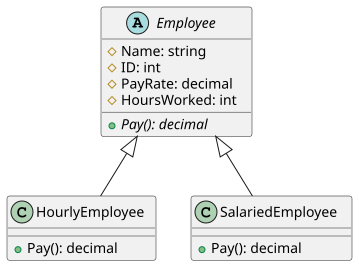Inheritance
An example in C++ follows:
importstd;usingstd::unique_ptr;usingstd::vector;classGameObject{public:virtualvoidupdate(){// no-op}virtualvoiddraw()const{// no-op}virtualvoidcollide(vector<GameObject>objects){// no-op}};classVisible:publicGameObject{private:unique_ptr<Model>model;public:virtualvoiddraw()constoverride{// code to draw a model at the position of this object}};classSolid:publicGameObject{public:virtualvoidcollide(vector<GameObject>objects)override{// code to check for and react to collisions with other objects}};classMovable:publicGameObject{public:virtualvoidupdate()override{// code to update the position of this object}};Then, suppose we also have these concrete classes:
- class
Player - which is Solid, Movable and Visible - class
Cloud - which is Movable and Visible, but not Solid - class
Building - which is Solid and Visible, but not Movable - class
Trap - which is Solid, but neither Visible nor Movable
Note that multiple inheritance is dangerous if not implemented carefully because it can lead to the diamond problem. One solution to this is to create classes such as VisibleAndSolid, VisibleAndMovable, VisibleAndSolidAndMovable, etc. for every needed combination; however, this leads to a large amount of repetitive code. C++ uses virtual inheritance to solve the diamond problem of multiple inheritance.
Composition and interfaces
The C++ examples in this section demonstrate the principle of using composition and interfaces to achieve code reuse and polymorphism. Due to the C++ language not having a dedicated keyword to declare interfaces, the following C++ example uses inheritance from a pure abstract base class. For most purposes, this is functionally equivalent to the interfaces provided in other languages, such as Java [4] : 87 and C#. [5] : 144
Introduce an abstract class named VisibilityDelegate, with the subclasses NotVisible and Visible, which provides a means of drawing an object:
classVisibilityDelegate{public:virtualvoiddraw()const=0;};classNotVisible:publicVisibilityDelegate{public:virtualvoiddraw()constoverride{// no-op}};classVisible:publicVisibilityDelegate{public:virtualvoiddraw()constoverride{// code to draw a model at the position of this object}};Introduce an abstract class named UpdateDelegate, with the subclasses NotMovable and Movable, which provides a means of moving an object:
classUpdateDelegate{public:virtualvoidupdate()=0;};classNotMovable:publicUpdateDelegate{public:virtualvoidupdate()override{// no-op}};classMovable:publicUpdateDelegate{public:virtualvoidupdate()override{// code to update the position of this object}};Introduce an abstract class named CollisionDelegate, with the subclasses NotSolid and Solid, which provides a means of colliding with an object:
importstd;usingstd::vector;classCollisionDelegate{public:virtualvoidcollide(vector<GameObject>objects)=0;};classNotSolid:publicCollisionDelegate{public:virtualvoidcollide(vector<GameObject>objects)override{// no-op}};classSolid:publicCollisionDelegate{public:virtualvoidcollide(vector<GameObject>objects)override{// code to check for and react to collisions with other objects}};Finally, introduce a class named GameObject with members to control its visibility (using a VisibilityDelegate), movability (using an UpdateDelegate), and solidity (using a CollisionDelegate). This class has methods which delegate to its members, e.g. update() simply calls a method on the UpdateDelegate:
importstd;usingstd::unique_ptr;usingstd::vector;classGameObject{private:unique_ptr<VisibilityDelegate>visibilityDelegate;unique_ptr<UpdateDelegate>updateDelegate;unique_ptr<CollisionDelegate>collisionDelegate;public:GameObject(VisibilityDelegate*v,UpdateDelegate*u,CollisionDelegate*c):visibilityDelegate{std::make_unique<VisibilityDelegate>(v)},updateDelegate{std::make_unique<UpdateDelegate>(u)},collisionDelegate{std::make_unique<CollisionDelegate>(c)}{}voidupdate(){updateDelegate->update();}voiddraw()const{visibilityDelegate->draw();}voidcollide(vector<GameObject>objects){collisionDelegate->collide(objects);}};Then, concrete classes would look like:
classPlayer:publicGameObject{public:Player():GameObject(newVisible(),newMovable(),newSolid()){}// ...};classSmoke:publicGameObject{public:Smoke():GameObject(newVisible(),newMovable(),newNotSolid()){}// ...};
